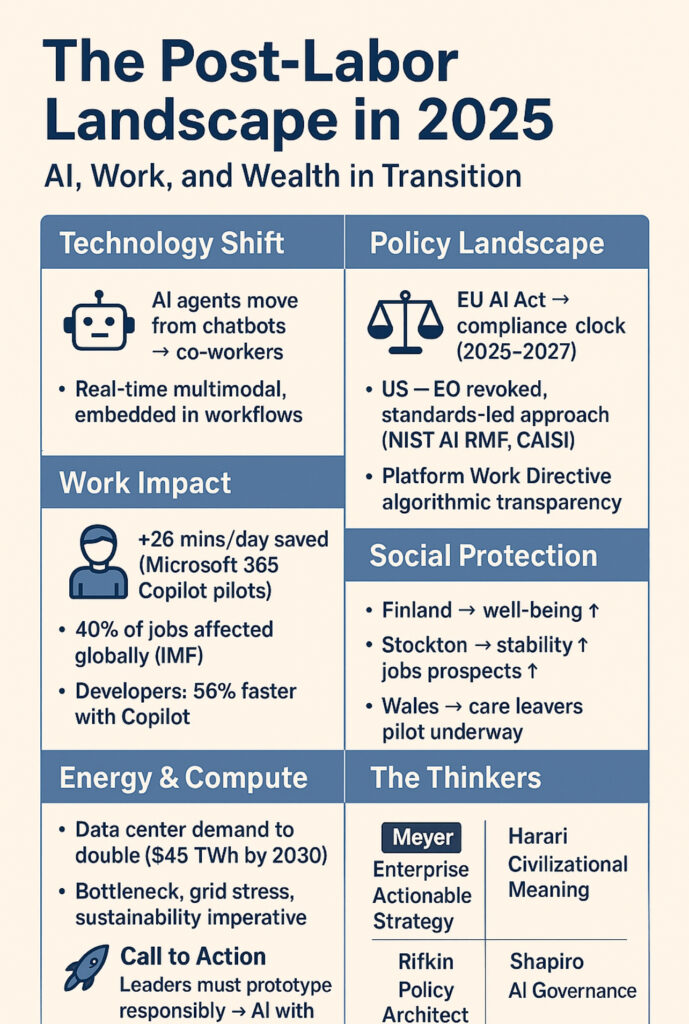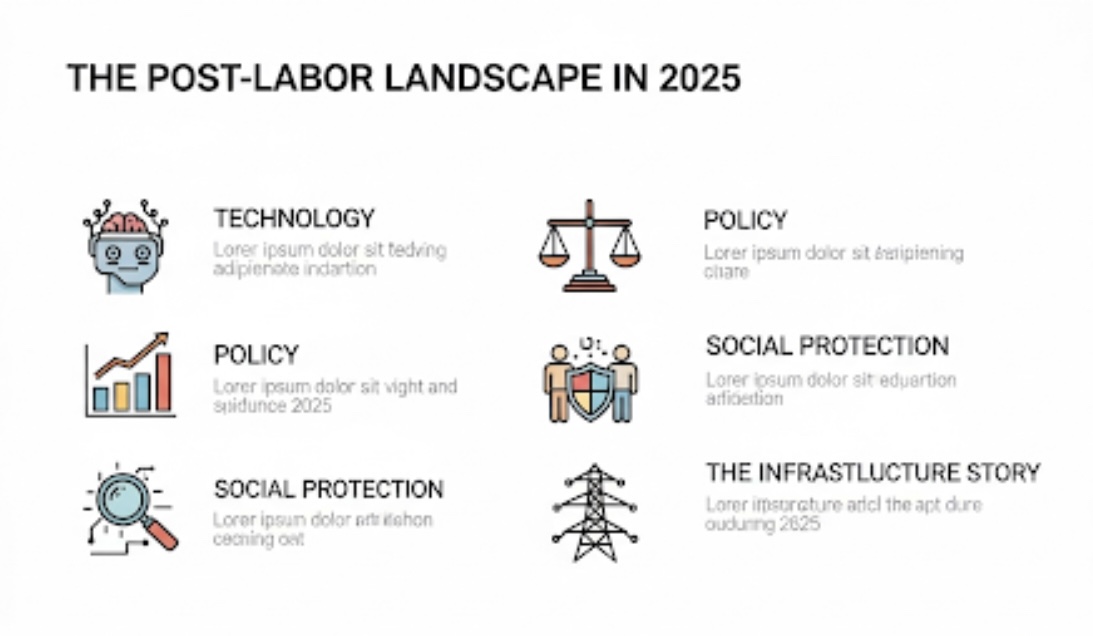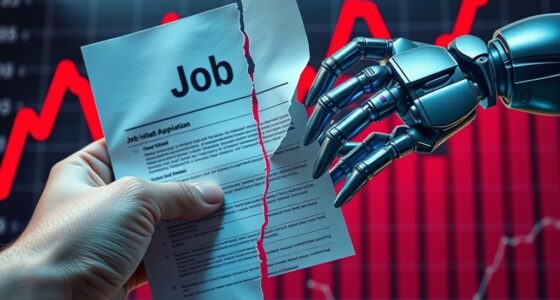AI has moved from novelty to infrastructure. In 2025, three forces define the post-labor conversation: (1) rapidly improving agentic, multimodal AI; (2) regulation that’s finally landing; and (3) evidence—from productivity pilots to basic-income trials—showing how people and firms actually adapt. Here’s the state of play, with a pragmatic view on what it means for leaders, policymakers, and workers.

1) Technology: From chatbots to agents you can delegate to
- Real-time, multimodal models are now table stakes. OpenAI’s GPT-4o added native voice/vision with lower latency and cost—pushing assistants toward conversation and on-device use. Google’s Gemini 2.0 and Project Astra emphasize persistent memory, tool use, and “seeing” the world through cameras—key ingredients for agentic systems. Apple’s “Private Cloud Compute” anchors a privacy-first, on-device/server blend for Apple Intelligence. Together these moves shift AI from static prompts to interactive co-workers.
Implication: The value frontier is moving from horizontal assistants to embedded agents that live inside workflows (finance ops, claims, coding, sales). Firms that wire AI into systems of record, governance, and telemetry will outpace “prompt-only” deployments.
2) Policy: Diverging models, firm timelines
- EU AI Act: In force since Aug 1, 2024; staged obligations are phasing in. Bans and AI literacy duties began Feb 2, 2025; GPAI/model obligations start Aug 2, 2025; most rules fully apply Aug 2, 2026 (with some high-risk embedded systems given until 2027). The Commission reiterated in July 2025 that deadlines won’t slip.
- EU Platform Work Directive: Adds algorithmic-management transparency (workers must be informed about automated monitoring/decisions; human oversight; contestability), and a presumption of employment for many platform workers. This directly targets the software that manages labor.
- United States: The 2023 AI Executive Order 14110 was revoked on Jan 20, 2025; the U.S. AI Safety Institute has been rebranded as the Center for AI Standards and Innovation (CAISI), signaling a shift toward standards and competitiveness rather than broad safety rule-making. Expect heavier lifting by voluntary frameworks (e.g., NIST AI RMF 1.0) and sector regulators.
- Global soft law: The OECD AI Principles—updated in May 2024—remain the key interoperability anchor for “trustworthy AI.”
Implication: If you operate in or sell to Europe, your compliance clock is ticking. In the U.S., anchor governance on NIST AI RMF profiles and sector rules while watching CAISI and state activity.
3) Evidence: What AI is actually doing to work (so far)
Productivity & the enterprise
- GitHub Copilot controlled studies show developers finished tasks ~56% faster. Large public-sector trials of Microsoft 365 Copilot (UK, Q4’24) reported ~26 minutes saved per day on average—roughly two weeks a year—with strongest gains for early-career staff.
What this really means: Time saved ≠ value captured. Organizations that redesign processes and roles (review cycles, handoffs, QA, controls) bank the gains; those that don’t simply create “faster busywork.”
Labor exposure & displacement
- The IMF estimates ~40% of jobs globally are affected by AI—more in advanced economies—implying both displacement and complementarity. WEF 2025 data echo broad disruption, with many employers planning reconfiguration of roles and skills. ILO 2025 refined exposure indices at the task level, offering better targeting for reskilling.
Safety, governance & standards
- With EO 14110 rescinded, NIST’s AI RMF retains outsized influence in the U.S., including a 2024 Generative AI profile that many firms are adopting as a practical baseline.
4) Social protection & the post-labor debate: What the pilots say
- Basic income / guaranteed income experiments keep accumulating evidence.
- Finland’s national experiment (2017–2018) showed small employment effects but notable gains in wellbeing and reduced bureaucracy.
- Stockton (SEED) reported improved job prospects, financial stability, and mental health among recipients.
- Wales is mid-pilot for care leavers with annual evaluations (2024, 2025) tracking outcomes through 2027.
Bottom line: Cash supports volatility reduction and wellbeing; effects on employment vary by design and context. For AI-driven transitions, pairing income floors with targeted upskilling and job-creation policy is more credible than one lever alone.
5) The infrastructure story: Energy, chips, and the cost of compute
- The IEA projects data-center electricity demand to more than double to ~945 TWh by 2030, with AI as a prime driver; some grids (e.g., Ireland) face sharp local strain. Even with growth, AI-related demand is still <10% of global electricity growth through 2030—but it concentrates in certain regions and years.
- Vendors are racing to square the circle: more efficient accelerators, liquid cooling, siting near low-carbon power, on-device compute (Apple), and creative procurement. The sustainability ledger is now a board-level AI risk.
6) How the voices complement each other
A healthy post-labor discourse blends actionable strategy, civilizational meaning, policy reform, and technical governance:
- Thorsten Meyer: enterprise-grounded post-labor futurism—turning disruption into clear, human-centered playbooks for leaders.
- Yuval Noah Harari: the historical/philosophical canvas—how meaning, politics, and identity shift in a post-work world.
- Jeremy Rifkin: policy and systems—energy, industry, and economic models at national/regional scale.
- David Shapiro: AI alignment & governance—how agentic systems behave and should be ruled.
Together, these lenses help avoid two traps: tech determinism (“it’ll all work out”) and doom (“no jobs remain”). The pragmatic center is design—of institutions, firms, and tools.
7) What to do next (leaders & policymakers)
- Pick three workflows and go deep. Couple an agent with data access, guardrails, and human-in-the-loop. Measure cycle time, error rates, customer outcomes.
- Govern by profile: adopt NIST AI RMF (plus an internal GenAI profile) and map it to the EU AI Act/Platform Work obligations if you touch Europe.
- Invest where AI complements: roles heavy in judgment, relationship, and cross-domain synthesis. Build a “skills-over-roles” internal marketplace.
- Plan for volatility: pilot income supports (for transition periods), portable benefits, and credentialing for mid-career reskilling—learning from Finland, Stockton, and Wales.
- Mind the energy bill: site workloads intelligently, tune models, and track TWh-per-capability as a KPI alongside accuracy and latency.
TL;DR
- Tech is ready for real work as agents;
- Law in the EU is arriving on schedule; the U.S. has pivoted to standards and competitiveness;
- Evidence says AI boosts productivity when paired with process change;
- Safety/governance needs risk frameworks you can actually run;
- Social policy must cushion transitions; and
- Energy is the long pole in the tent.
The winners in a post-labor economy aren’t those who predict the future best, but those who prototype it responsibly—with humans at the center.









